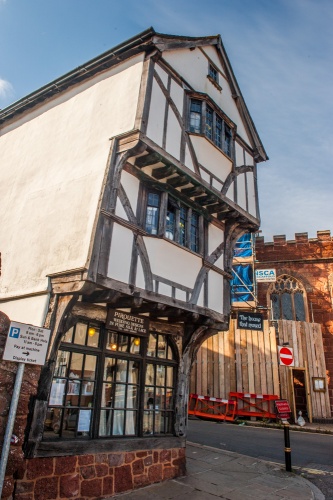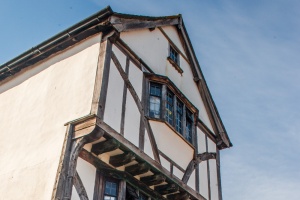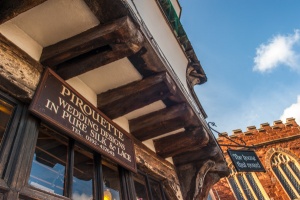
Exeter is blessed with an exceptional array of historic buildings from the medieval cathedral to section of the old Roman wall. One of the most fascinating buildings stands on West Street at the bottom of St Mary Steps. Here you will find a three storey timber-framed merchant's house that goes by the colourful name of The House that Moved.
The story of how the house came to move is a remarkable one, but let's start with the building itself. Very little is known about its early history, and it has been described as everything from 14th to 16th century. It was most likely built around 1450, which would make it one of the oldest timber-framed houses in Devon. It has a kitchen at the rear, a first-floor hall, and a solar, or family bedchamber, on the second floor.
One of the most unusual features is the cusped wooden windows on the first and second floors. The most obvious feature is how far each floor projects out over the one below. It really is quite striking, especially when you stand directly under the first floor overhang and look up.

The name 'The House that Moved' is as much a description as it is a moniker; the house quite literally moved from its original home at the corner of Edmund Street and Frog Street. Before its move the building was known simply as 'Merchant House', and stood at Number 16 Edmund Street. In the 1950s Exeter's city government embarked on a major plan to improve traffic flow and bypass the entire city centre. Frog Street was scheduled to be demolished in its entirety to make way for the new road system.
When the fate of the listed historic house became known, local historians campaigned to have it saved. Their intervention was successful, and the building was 'listed', meaning that efforts had to be made to preserve it i possible. The government contributed £10,000 towards the cost of moving the entire building to a new location. A vacant lot was found on West Street, 220 feet (70m) away. Here's where the story gets really odd.
The lot was vacant because a 15th-century timber house on that spot had been torn down in the 1940s. That house had been offered to the city council, but the council had not been interested in saving it, so the housebuilding was demolished. Now history was repeating itself, and the council was moving another 15th century timber-framed house to stand in the exact same spot.

The House Moves
To move the entire house was a major project. The building was stripped to its frame, windows removed, then protected by a timber casing. The entire building was jacked up and set on metal wheels.
To avoid damage to the historic timbers no iron screws or bolts were used. A framework of timbers was installed to strengthen the building against sideways slippage during the move. The house itself weighed 21 tons and the timber frame another 10 tons.
Starting on 9 December 1961 the building was moved on rails to its new home, a process that took 6 days and was watched by newsreel cameras and a horde of newspaper reporters.
Frequent checks had to be made with spirit levels to make sure that the entire structure stayed upright during the slow, painstaking journey. Despite the fact that the street had a gradient of as much as 1 in 10 the journey passed without incident. After the house was set on its new foundations a window removed for the journey was reinstalled and the medieval timbers were treated for woodworm.
The House that Moved strikes a rather odd note in its current home. The house is exposed on three sides and juts out from its neighbours to a striking extent. It stands across from the medieval church of St Mary Steps, known for its unusual clock, and a pair of timber-framed houses beside Stepcote Lane.
As of this writing, The House that Moved is occupied by a wedding dress shop. If you look like you are in the market for a dress you could try going into the shop, but for the rest of us, we'll have to be satisfied with examining the building from the outside.
It's a peculiar location; though the house itself is interesting, especially if you're a bit of a fanatic about timber-framed houses like I am, but the setting is a bit of a let-down. The house stands next to a car park and is overwhelmed by a four-lane bypass road, with traffic whizzing past a few steps from the building.
About The House that Moved
Address: 24 West Street,
Exeter,
Devon,
England, EX1 1BA
Attraction Type: Historic Building
Location: At the bottom of Stepcote Lane opposite St Mary Steps church. Signposted from the city centre.
Location
map
OS: SX917922
Photo Credit: David Ross and Britain Express
NEARBY HISTORIC ATTRACTIONS
Heritage Rated from 1- 5 (low to exceptional) on historic interest
Tucker's Hall - 0.1 miles (Historic Building) ![]()
Exeter Old Bridge - 0.1 miles (Historic Building) ![]()
Cricklepit Mill - 0.1 miles (Historic Building) ![]()
Exeter, St Olave's Church - 0.1 miles (Historic Church) ![]()
St Nicholas Priory - 0.1 miles (Historic Building) ![]()
Exeter Custom House - 0.2 miles (Historic Building) ![]()
Quay House - 0.2 miles (Museum) ![]()
Exeter, St Pancras Church - 0.3 miles (Historic Church) ![]()
Nearest Holiday Cottages to The House that Moved:
Stoke Canon, Devon
Sleeps: 16
Stay from: £2751.00 - 18156.00
More self catering near The House that Moved







